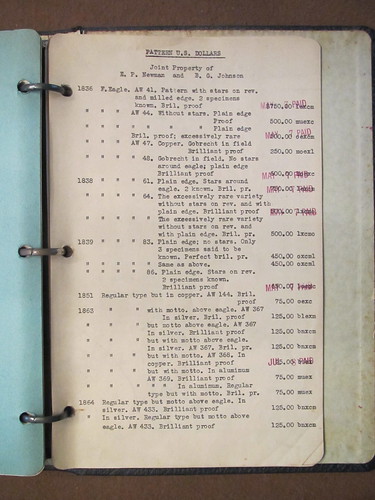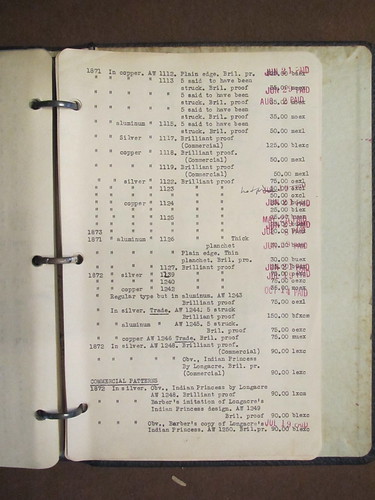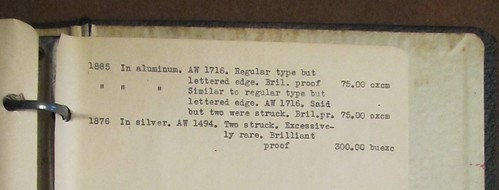
PREV ARTICLE
NEXT ARTICLE
FULL ISSUE
PREV FULL ISSUE
B. G. JOHNSON’S LEDGER: NEWMAN DOLLAR PATTERNS
Stuart and Maureen Levine submitted this article about
-Editor
Stu and I are enjoying a beautiful Sunday in St. Louis, sitting in Eric and Evelyn Newman’s dining room, examining some of B. G. Johnson’s ledger books from the early 1940s. All coins in the ledger were purchased from the “Colonel” Green Estate. A section titled “PATTERNS U.S. DOLLARS, Joint Property of E. P. Newman and B.G. Johnson” appears in one of these books. We thought your readers might be interested in some of the timely information within.

Joint Property We photographed the ledger pages with entries for three patterns that will be offered in the CSNS auction of Selections from the Collection of Eric P. Newman. Envelopes accompanying the coins in the auction catalog reflect their entries in the ledger. The retail price appears in dollars; the cost is in B.G. Johnson’s code.

1872 Dollar The relevant entry in the first photo is as follows: “[1872 in] copper AW 1246 Trade. Bril. proof 75.00 muex.” The Heritage auction catalog information appears below. 1872 T$1 Trade Dollar, Judd-1221, Pollock-1363, High R.7, PR66 Red and Brown NGC. CAC. Design. The obverse is the William Barber adaptation of Longacre's Indian Princess design. She faces left, with 13 stars each around and on the flag, a large globe inscribed LIBERTY in raised letters, date 1872 below. The reverse is the first Trade dollar pattern, copying the Commercial dollar patterns. A wreath with UNITED STATES OF AMERICA at upper rim, and inside TRADE/DOLLAR/(bar ornament)/420 GRAINS. 900 FINE/(bar ornament). IN GOD WE TRUST is on the ribbon of the wreath. Struck in bronze with a reeded edge. Commentary. Less than half a dozen examples of this Trade dollar pattern are known and this is the first that we have handled. The actual surviving population may be as low as three or four pieces. Nearly a decade has passed since the last market appearance of this pattern variety. Prior to certification of the Newman specimen, NGC and PCGS had each certified a single PR63 Red specimen. The two grading events almost certainly represent a single coin that appeared in a 1994 Bowers and Merena sale as PR63 Red PCGS, and reappeared in a 2003 American Numismatic Rarities sale as PR63 Red NGC. Physical Description. Lightly mirrored and fully brilliant orange surfaces host delicate blue patina, with 90% of the original mint color remaining. A sharp strike and excellent eye appeal are evident. Provenance. "Colonel" E.H.R. Green; Green Estate; Partnership of Eric P. Newman / B.G. Johnson d.b.a. St. Louis Stamp & Coin Co.; Eric P. Newman @ $75; Eric P. Newman Numismatic Education Society. From The Eric P. Newman Collection. (PCGS# 71493)

1873 Dollar The pertinent entries in the next photo are of two 1873 Trade dollars: “[1873 In] silver. Obv., of AW 1317. Rev., AW 1328 Plain edge. Not in AW. Brilliant proof Trade 50.00 moex” and a duplicate“1873 In silver. Obv., AW 1317. Rev., 1328. Plain edge. Not in AW. Brilliant proof 50.00 moex .” Eric P. Newman chose the finer specimen. Heritage’s description follows. 1873 T$1 Trade Dollar, Judd-1294, Pollock-1436, High R.7, PR66 NGC. Design. The obverse depicts Liberty seated with her left hand resting on a globe and a Liberty pole and cap in her right hand. Bales of cotton, a sheaf of wheat, and a short-handled plow are nearby. Thirteen stars around and the date below. The reverse features Barber's Amazonian style eagle, but with a ribbon inscribed E PLURIBUS UNUM in the beak. UNITED STATES OF AMERICA above and fineness and denomination below. Struck in silver with a plain edge. Commentary. Judd-1294 was offered for sale to collectors in six-piece sets, including five other Trade dollar patterns, for $30 in 1873. Only about six examples remain, with a total of five submission events recorded at NGC and PCGS combined. This coin is tied with one PR66 Cameo NGC example for the finest numerical grade at either grading service. As noted on the envelope, this issue was not included in the Adams-Woodin pattern reference, although Pollock mistakenly lists AW-1317, which shares the same obverse, as its equivalent. Physical Description. This delightful Premium Gem is sharply detailed in most areas, with just a touch of softness on the eagle feathers. Attractive shades of pink, gray, and cerulean-blue patina blanket the well-preserved surfaces, and traces of reflectivity shine through the toning. Eye appeal is outstanding. Census: 1 in 66, 0 finer (2/13). Provenance. "Colonel" E.H.R. Green; Green Estate; Partnership of Eric P. Newman / B.G. Johnson d.b.a. St. Louis Stamp & Coin Co.; Eric P. Newman @ $50; Eric P. Newman Numismatic Education Society. From The Eric P. Newman Collection. (PCGS# 61579)

1885 Dollar The third photo of a ledger page contains the entries for two specimens of the “Snowden Dollar,” the better of which was retained by Eric P. Newman: “1885 In aluminum. AW 1716. Regular type but lettered edge. Bril. proof 75.00 oxcm” and “[1885 In aluminum] Similar to regular type but lettered edge. AW 1716. Said but two were struck. Bril. pr. 75.00 oxcm.” The Heritage catalog description appears below: 1885 P$1 Snowden Dollar, Judd-1749, Pollock-1961, Low R.7, PR68 Cameo NGC. CAC. Design. The dies are the regular-issue 1885 Morgan dollar dies, but there is experimental edge lettering as follows: * * * * * * E * / PLURIBUS * / UNUM * * * * *. Struck in aluminum with a tripartite collar for the edge lettering. Commentary. The so-called Snowden dollars were struck as an anti-counterfeiting measure, following the arrest in 1884 of two skillful counterfeiters. The edge was struck from a novel three-part collar that produced raised edge lettering on the coin. Considerable experimentation went into the production of these pieces, and on June 12, 1885 Snowden and his staff succeeded in getting the mechanism to work at normal production speeds of 80 to 100 coins per minute. Snowden retired at the end of the year, and left placement of the raised lettering to his successor. Director Burchard left office around the same time, and no one remained in the Mint who had Snowden's insight, ability, or willingness to experiment to carry his project forward to completion. Physical Description. This dollar is essentially "as struck." The nearly brilliant surfaces show no obvious contact marks on either side. The fields are deeply mirrored and show evidence of die polishing. Contrasted against the depth of mirroring on each side, the devices are noticeably frosted, producing a strong field-device contrast. Contrast is almost expected on aluminum patterns. These pieces struck up nicely and a high percentage display deep mirroring and cameo contrast. Additionally, this nearly perfect piece does not show any of the planchet laminations or streakiness often encountered in aluminum coinage. Nor is there any trace of oxidation. This is the only PR68 Snowden dollar certified at either grading service, and it is followed by a pair of PR67 Cameo coins, one at NGC and one at PCGS as the second finest examples known (2/13). Provenance. "Colonel" E.H.R. Green; Green Estate; Partnership of Eric P. Newman / B.G. Johnson d.b.a. St. Louis Stamp & Coin Co.; Eric P. Newman @ $75; Eric P. Newman Numismatic Education Society. From The Eric P. Newman Collection. (PCGS# 62191)
Items being sold are from the extensive collection of Eric P. Newman Numismatic Education Society (a Missouri not-for-profit corporation) and have been assembled over a period of 90 years. Proceeds of the sale of all items will be used exclusively for the benefit of other not-for-profit institutions selected by Eric P. Newman Numismatic Education Society for public purposes and also for supplementing the Society's own museum operations and scholarly research efforts.
The Numismatic Bibliomania Society is a non-profit organization promoting numismatic literature. See our web site at coinbooks.org. To submit items for publication in The E-Sylum, write to the Editor at this address: whomren@gmail.com To subscribe go to: https://my.binhost.com/lists/listinfo/esylum All Rights Reserved. NBS Home Page Contact the NBS webmaster 
|